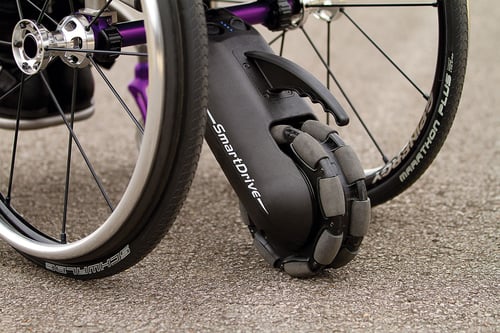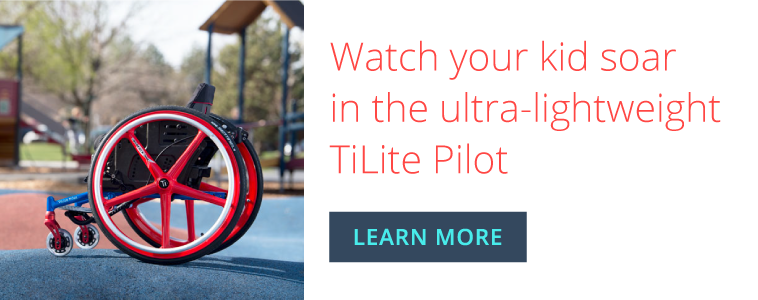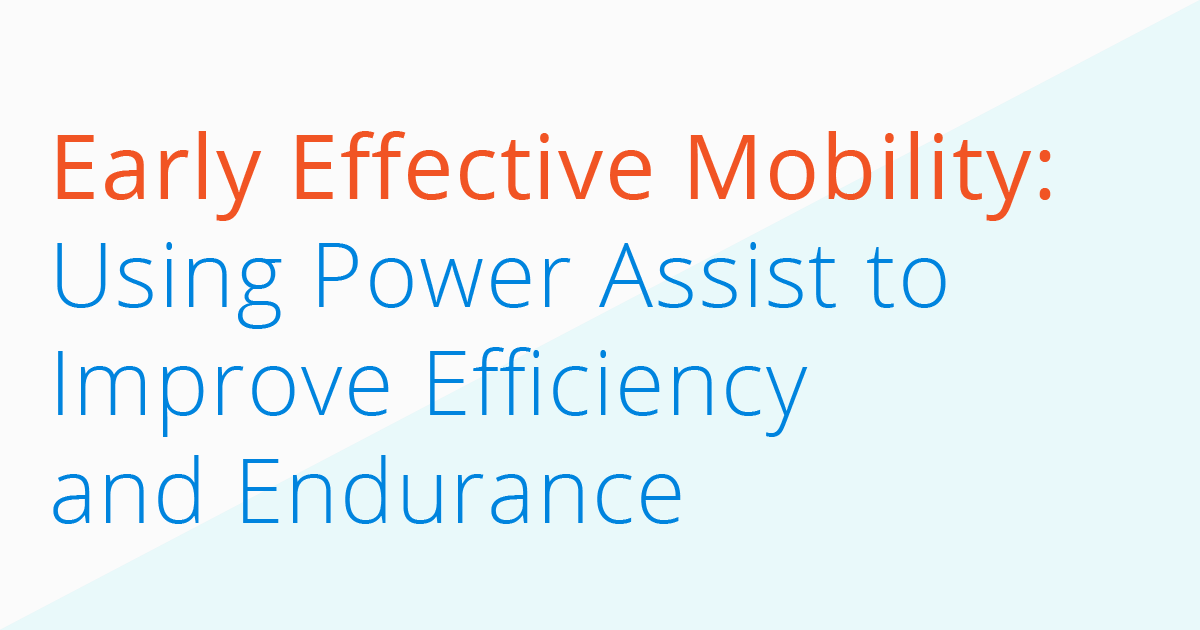Part 5 in our series looking at pediatric independent manual mobility. See Part 1, Part 2, Part 3, and Part 4.
We have been discussing the topic of early effective mobility for the past couple weeks. We’ve established the importance for childhood development and began looking at the options available for early effective mobility, specifically independent manual mobility. There are many advantages to manual mobility, especially when it comes to transport. So, this week we are going to discuss a technology that can improve efficiency and endurance when using manual mobility: power assist.
What is a wheelchair power assist device?
Power assist is simply the use of technology to assist with the “push” phase of independent manual wheelchair propulsion. This technology can reduce the push frequency and force required for effective mobility. This “assist” can come through the wheels, or through a rear removable add-on to the wheelchair. It is important to know the advantages and disadvantages of each when considering potential power assist options for your child’s wheelchair. But first let’s consider what counts as effective propulsion without assistance.
What does the literature say about effective independent manual wheelchair propulsion?
There are recommendations in literature that tell us how to optimize manual wheelchair propulsion:
- Minimize push frequency
- Use a semi-circular push pattern
- Use lightest wheelchair possible with proper rear axle placement
- Maintain ideal body weight of person in the manual wheelchair
- Long smooth/less frequent strokes
- Proper wheelchair fit
(Collinger, JL, et.al 2008)
These are great recommendations to discuss with your child’s therapist to ensure that he is optimizing his manual wheelchair propulsion for daily tasks. But what if these recommendations have been satisfied and your child isn’t as effective as he can be with his daily mobility? This may be the time to consider using power assist.
When would I consider power assist for my child?
When thinking about early effective independent mobility consider the child’s daily activities. Remember to include not only what she needs to do, but also what she wants to do and ask yourself the following questions:
- Is my child complaining of pain in her shoulders? If yes, when does she notice this pain?
- Does my child tire quickly during certain parts of the day? Is there a pattern?
- Does my child demonstrate the endurance to do all the activities he wants to do during the day?
If you have concerns regarding any of these questions, it may be that your child could benefit from a power assist device. Talk to your child’s therapist and rehab technology supplier to begin this discussion and focus on maximizing your child’s ability to effectively participate in the activities that she chooses. Here are the types of technology to discuss with your seating specialist to determine which will work best for your child and your family.
Types of Power Assist Technology
Through the Push Wheels:
How it works:With this style of power assist, the motor is in the wheels. When using the power assist through the wheels, they are activated through force on the push-rims. That force triggers sensors which signal the motors to propel the wheels forward.
Benefits:
- Can be programmed for sensitivity, boost and speed
- Very little force is required to activate
- May offer slope deceleration assist which can help maintain a comfortable speed when going down grades and ramps
Considerations:
- It is important to consider the added weight to the wheelchair: up to 22lbs per wheel, and wheels need to be removed to facilitate transport in a vehicle.
- Need to protect the wheels during transport so that sensors don’t get damaged.
- The wheels can not be turned off in different environments such as the classroom, as the wheels will add dead weight.
- If the battery dies the wheels provide a resistance and all the weight is in the wheels.
- Will add additional width to the chair, which could limit access in narrow areas such as doorways and restrooms
Rear Mounted Power Assist:

An alternative power assist method is a single motor add-on component that weighs 12.5lbs and is detachable. It is controlled by the Pushtracker, which is an accelerometer based wearable band, similar to say, a FitBit. When tap gestures are recognized, they signal the motor via Bluetooth. A double-tap activates the motor. It then begins to accelerate at a rate programmed by you. A single tap locks in your speed, at which point all you need to do is steer the chair. When you want to stop, another double-tap disengages the motor, at which point you will coast and break with your hands.
Benefits:
- Easily taken on and off for vehicle transfers or transport
-
Acceleration and top speed is programmable, allowing for safe operation
-
Does not provide an added burden when a child wants to turn off the power feature in select environments such as the classroom.
-
Weather sealed, so rain and puddles won’t affect it
-
If battery dies, no increased resistance with the rear mounted assist as it freewheels
-
It is fast charging and can be fully charged in 2.5 hours
Considerations:
- User must be able to control rate of descent down grades and ramps. ADI disc breaks are a separate product that can be added to the chair to assist with deceleration.
Now that we’ve shown you the power assist options and their various features, you can have a more informed discussion with your seating specialist regarding the best option for your child and your family. Join me next week as I discuss one of the power assist technologies on the market: Smart Drive. I will discuss this innovative technology with our resident expert Devon Doebele and answer some of the questions you might have related to power assist for your child.

Glossary of Terms
Self-Awareness: An awareness of one's own personality or individuality
Spatial Orientation: An awareness of one’s position in space
Emotional Attachment: Feeling connected to others
Visual/Vestibular Integration: The connection between vision and balance for navigating one’s environment
Initiation: The act of initiating or beginning something
Trunk Stability: The ability to maintain a position of the upper body
Range of Motion: The range that a joint is able to move
Dependent Manual Wheelchair: A wheelchair that can not be moved without assistance
Independent Manual Wheelchair: A wheelchair that can be moved independently
Visual Motor Skills: The ability to synchronize visual information with physical movement, driving a car or playing a video game of skill
Depth Perception: The visual ability to judge depth or distance
Position in Space: Knowing where your body is in space relative to surrounding objects
Socialization: The ability to interact with others
Mobility: The ability to move
Ultralight Manual Wheelchair: Made of ultra lightweight materials such as aluminum, titanium, or carbon. Usually can be configured to fit the individual user
Dictionary. (2018). Retrieved from https://www.merriam-webster.com/dictionary/self-awareness?src=search-dict-box
References:
1. Collinger JL, Boninger ML, Koontz AM, et al. Shoulder Biomechanics During the Push Phase of Wheelchair Propulsion: A Multi-Site Study of Persons with Paraplegia. Arch Phys Med Rehabil. 2008; 89(3): 667-676.

Stacey Mullis, OTR/ATP
Director of Clinical Marketing
Stacey is Director of Clinical Marketing. She graduated from Western University in London, Ontario, Canada with a BA Linguistics and BSc Occupational Therapy and has practiced as an OTR for over 20 years. With experience in pediatrics, inpatient/outpatient rehabilitation, long term care, and home health, Stacey has faced the challenges first hand of providing appropriate seating in various clinical settings. This led her to pursue an apprenticeship at Care Partners Seating Clinic in Asheville, NC to advance her skills, and she obtained her ATP certification in 2012. Mullis is a member of the NCOTA, CTF, NRRTs, RESNA, and AOTA.
